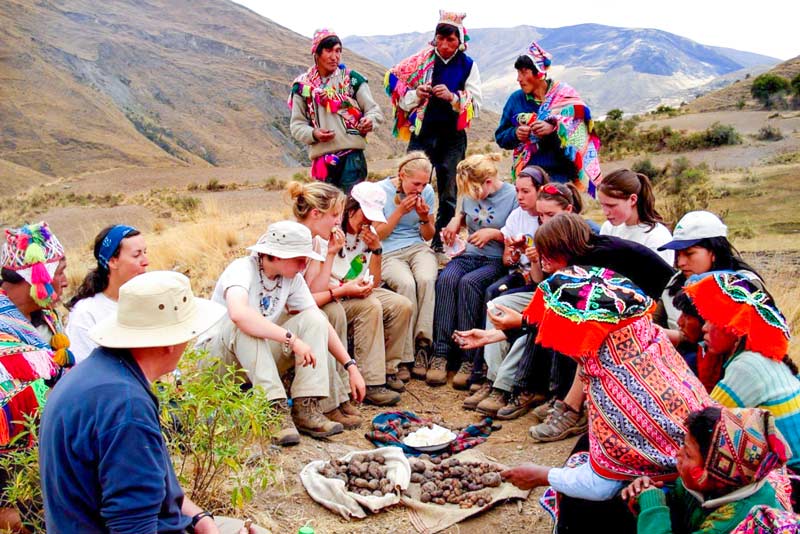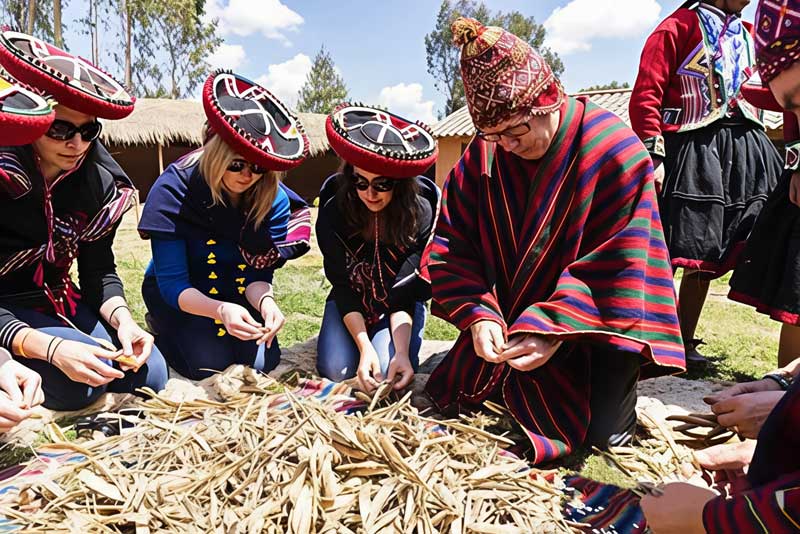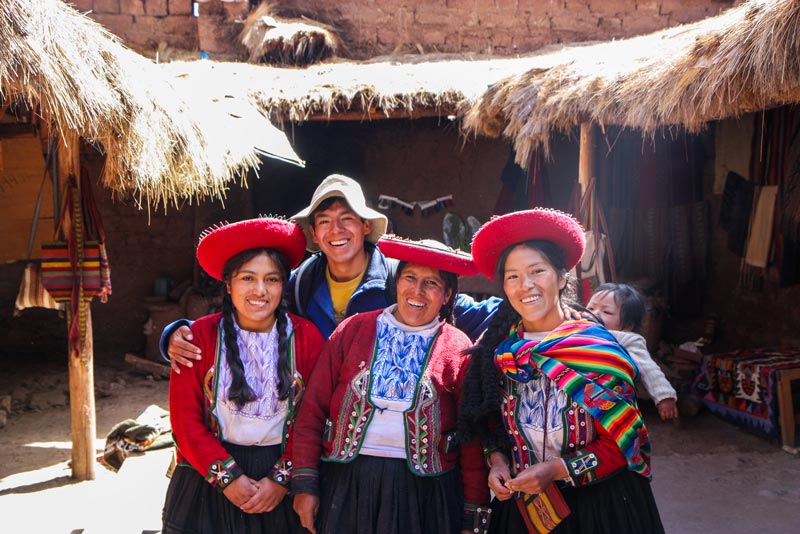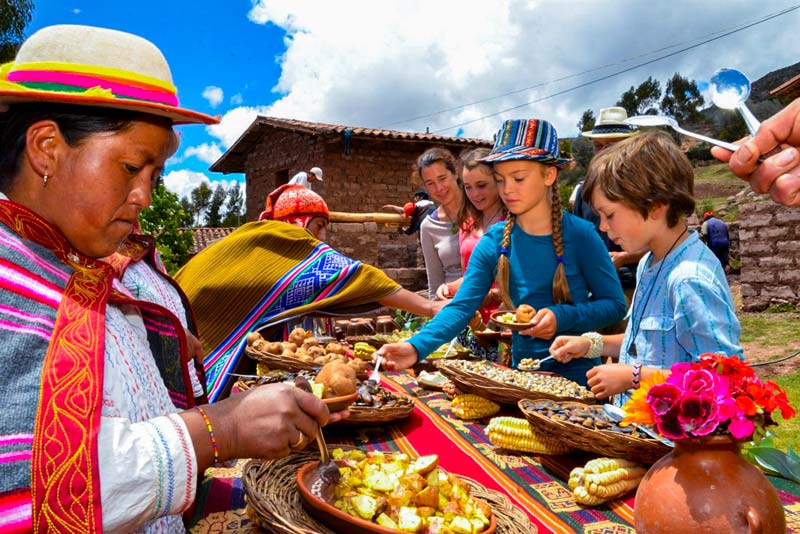Experiential and Community Tourism in Cusco
Cusco offers a wide variety of tourist options that amaze us day after day, but beyond these popular destinations, we find unusual experiences that further enrich our adventure. Experiential tourism in Cusco is increasingly impactful, inviting visitors to immerse themselves in the culture of people and communities to gain a broader perspective on their traditions and daily activities, which adds even greater value to our trip.
- What is experiential and community-based tourism?
- Living experience in Raqchi
- Experiential experience at Willoq
- Experiential experience with the Q’eros community
- Experiential experience in Chinchero
- Experiential experience in Misminay
- Comparative table between classic tourism and experiential tourism
- Types of experiential tourism in Cusco
- Recommendations for a better living experience
- Frequently asked questions
What is experiential and community-based tourism?
Experiential tourism introduces us to the daily lives of towns and communities. It’s not a superficial form of tourism where we simply visit; part of the experience of this type of tourism is immersing ourselves in the culture by participating in its activities and traditions. The learning we gain from experiencing a different side makes us appreciate more what we call different, allowing us to understand all the good it contains.
Experiential and community-based tourism also offers us a sustainable way to enrich our trip, both socially and environmentally. This means that our visit helps communities continue to preserve their culture, as the economic benefits accrue directly to them. The transformation that comes from experiencing these practices makes us value the natural environment, believing in and being part of it, as well as their culture, understanding their way of seeing the world.
Another important point is that, with these experiences, we dedicate our time and actions to less-crowded destinations, generating less congestion in popular places. These actions allow us to preserve them over time.
Immerse yourself in experiential tourism.
Every experience with the communities that live in Cusco is an opportunity to learn about different perspectives on thinking and seeing the world. It’s not enough to simply visit their workshops or observe their traditions; experiential tourism invites you to become part of them. Spending a night, or more than one, helps you better understand why they believe what they believe, allowing you to broaden your perspective and thus transform yourself through the lessons you’ll experience and witness.
Living experience in Raqchi
The Raqchi community is located near Sicuani, south of Cusco. This site is home to an archaeological complex, the most important of which is the Temple of Wiracocha. The community is made up of approximately 80 families, who will immerse you in their culture, teaching you about their ecological agricultural practices. You’ll also have the opportunity to see their handicrafts and pottery making in an interactive workshop, accompanied by dance and music from the community members who wear their traditional attire every day.
Experiential experience at Willoq
The Willoq indigenous community is located in the Patacancha River Valley, within the Ollantaytambo district . This community is said to be one of the last with direct descendants of the last Incas. Upon arrival, you’ll be amazed by many things, starting with their clothing, which is made using ancient techniques with unique patterns and colors.
Visiting Willoq means immersing yourself in a culture steeped in mystical aura. You’ll learn about its textile art firsthand through workshops. You’ll also learn about Andean agriculture using the area’s native produce. Finally, you can immerse yourself in a “Payment to the Earth” (Payment to the Earth), a spiritual experience where we express gratitude to Mother Earth and the environment for providing us not only with the joy of the experience, but also for life and the good fortune of being here.
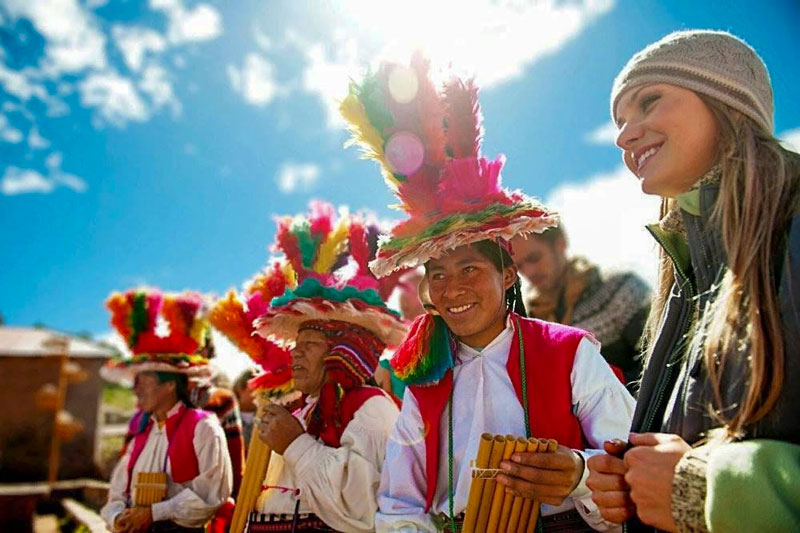
Tourist enjoying the festivities in the Willoq community
Experiential experience with the Q’eros community
The Q’eros community is located in a remote area in the province of Paucartambo, Cusco. For a long time, this community remained “hidden” from the rest of civilization. Their knowledge was first heard and learned 60 or 70 years ago. Immersing ourselves in their culture and traditions reveals a different way of understanding everything.
They live in a close relationship with nature, which seems to dictate their actions and allows them to see life from such different angles that they can even find answers and solutions to physical and emotional health problems. Many stories speak of the Q’ero inhabitants as almost magical beings, whose unique way of seeing reality allows them to access it in ways unknown to others.
Experiential experience in Chinchero
The community of Chinchero belongs to the Sacred Valley of the Incas. While it’s a popular destination for tours and excursions, there are ways to appreciate its culture in a more immersive way. The most notable experience within this community is learning about its textile industry. In detailed workshops, the artisans explain how they obtain alpaca and other auchenid fibers. They then show you how they dye them with plants, minerals, and even cochineal.
If you’re lucky, you might have the opportunity to witness one of the Chichero community meetings, where, using native instruments such as the “pututus,” they appear to call upon the Apus (gods) to receive blessings and ask for prosperity for their lands.
Experiential experience in Misminay
The Misminay community is located in the mountains of Cusco, near the Maras community. As part of this experience, you’ll learn about their deep connection with nature and how they live hand in hand for mutual prosperity. They’ll teach us about the agricultural calendar and their ancestral farming practices using tools such as the lampa, chaquitaclla, and oxen. We’ll also appreciate their cuisine, where we’ll learn about Andean flavors based on potatoes, corn, and locally grown plants steeped in history.
Comparative table between classic tourism and experiential tourism
| Aspect | Classic Tourism | Experiential Tourism |
|---|---|---|
| Aim | Visits to iconic locations following pre-established routes and programs. | Immersion in local culture through personalized and authentic experiences. |
| Itinerary | Fixed and planned routes. | Flexible itineraries tailored to individual visitor interests. |
| Cultural Interaction | Limited, since it focuses on the observation of monuments and historical sites. | High interaction, with direct participation in local activities and customs. |
| Type of Activities | Guided tours of archaeological sites, nature walks, among others. | Cooking workshops, craft classes, community gatherings, and life-changing experiences. |
| Economic impact | It does little to benefit communities and encourages mass tourism. | It promotes local development and sustainable tourism, generating direct benefits for the community. |
| Sustainability | It can lead to overexploitation of a site if it is not managed properly. | Focused on cultural and environmental preservation, promoting responsible practices. |
| Traveler’s experience | Informative and structured, ideal for those who want to know the main attractions. | Enriching and transformative, perfect for those seeking to experience the essence of their destination. |
Types of experiential tourism in Cusco
The life experiences in communities within Cusco are so varied that each one offers you enough insight to understand what you see in a different way, discover which ones stand out, and experience them all firsthand.
- Volunteer Tourism: This experience is more focused on community outreach activities. Whether using your knowledge or strengths, you can cover a wide range of dynamics and locations in a cooperative effort where everyone wins and learns.
- Ecotourism: This form of tourism is aimed at preserving the environment and biodiversity. It allows you to learn more about the native flora and fauna of the areas you visit. This allows you to get away from crowded places and enjoy experiences immersed in nature.
- Agritourism: This activity allows you to have a more direct contact with learning; its purpose is educational. There is also the possibility of working with farmers to learn about their techniques firsthand and thus preserve their knowledge and traditions.
Combine your destinations
Remember that when visiting destinations like Machu Picchu, the Sacred Valley, Rainbow Mountain, and all of Cusco through Boletomachupicchu , you can combine it with immersive experiences in the culture of the communities and towns, making your tour not just a visit, but a complete immersion learning about their culture and traditions.
Recommendations for a better living experience
- Immerse yourself more closely with the communities by spending the night in their homes and learning about their experiences and traditions.
- Be open-minded to learning; much of what you see and hear will be so surprising that you should be open to any possibility.
- Enjoy the landscapes and starry skies that the remote locations of these communities offer.
- Always stay warm and wear rain gear, as the weather in Cusco can be very unpredictable.
- Purchasing handicrafts or supporting them financially gives communities greater incentives to help them preserve their culture and traditions.
- Acclimatization is essential for visiting communities in Cusco. Try to spend at least a couple of days there before venturing to higher altitudes.
- Keep a notebook or something to write down your experiences so you don’t miss any details and make them last forever.
Frequently asked questions
1) What is Experiential and Community Tourism?
It is the experience of immersing oneself in the daily life and traditions of communities, actively participating in their cultural activities and ancestral practices.
2) Which communities offer experiential experiences in Cusco?
Some of the most notable experiences take place in Raqchi, Willoq, the Q’eros community, Chinchero, and Misminay.
3) What activities can I do during an experiential experience?
You can participate in craft workshops, agricultural practices, ancestral rituals, and social gatherings that connect you directly to the local culture.
4) How does experiential tourism differ from traditional tourism?
While traditional tourism focuses on visits to iconic sites with fixed itineraries, experiential tourism invites you to a personalized immersion in the life and traditions of the communities.
5) What types of experiential tourism exist in Cusco?
Among the options are volunteer tourism, community tourism, ecotourism, and agrotourism, each with a special focus on interaction and direct learning.
6) How does this tourism contribute to local development and sustainability?
By generating direct economic benefits for communities and promoting responsible cultural and environmental practices, it helps preserve local heritage and reduce overcrowding in popular destinations.
7) What recommendations should I follow for a better life experience?
It’s essential to acclimatize, wear appropriate clothing, keep an open mind, stay in local homes if possible, and support the community by purchasing handicrafts or making financial contributions.
8) Is it safe to participate in these activities?
Yes, communities take care of every detail and offer controlled experiences, ensuring a safe and respectful environment.
9) What languages are used during the experiences?
Spanish and Quechua are generally spoken. If you don’t speak either language, support or translation is always available.
10) Can experiential experiences be combined with traditional tourism?
Yes, many travelers choose to tour Cusco’s iconic sites and then immerse themselves in the traditions of its communities.
11) What is the usual duration of these experiences?
The duration varies, from a few hours to stays lasting several days, depending on the level of immersion you desire.
12) Are there options for families and children?
Yes, many experiences are tailored to suit all audiences, allowing entire families to enjoy the local culture together.
Advice from people who have been there
 By: Luis Z.
By: Luis Z.“Experience with Q'eros“
“Upon arrival, I was greeted by a community with an almost mystical connection to nature. Participating in their rituals and listening to their stories made me realize that sometimes the answers to our daily problems are hidden in the simplicity of community life. If you are looking for more than just a photo in a spectacular landscape, and you long to feel the very essence of Cusco, I recommend that you venture to live the Q'eros experience: you will take with you a little piece of their spirit and a new way of seeing the world.“
By Ticket Machu Picchu – Last updated, March 13, 2025
